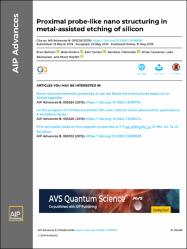Proximal probe-like nano structuring in metal-assisted etching of silicon

Göster/
Tarih
2019Yazar
Bahçeci, ErsinEnders, Brian
Yamani, Zain Hassan
Tokmoldin, Serekbol
Taukenov, Aman
Abuhassan, Laila
Nayfeh, Munir
Üst veri
Tüm öğe kaydını gösterKünye
Bahceci, E., Enders, B., Yamani, Z., Tokmoldin, S., Taukenov, A., Abuhassan, L., Nayfeh, M. (2019). Proximal Probe-like Nano Structuring in Metal-assisted Etching of Silicon. AIP Advances. 9(5), 055228. https://doi.org/10.1063/1.5096659Özet
We use silicon having multiple crystalline orientation domains and high metal doping in metal assisted chemical etching (MACEtch) in HF/H2O2. In device-quality silicon, MACEtch produces high-aspect ratio anisotropic (1-D) structures (wires, columns, pores or holes) and to a lesser degree non-high-aspect ratio luminescent (0-D) nano structures. While the 1-D structure symmetry is understood in terms of crystallography axis-dependent etching, predominantly along the <100> direction, the isotropic 0-D spherical symmetry etching is not understood. We observe in silicon having multiple crystalline orientation domains formation of metal tips (needles or whiskers) of diameters as small as 2-3 nm that bridge the metal to silicon and cause AFM/STM-like nanofabrication, producing 0-D mounds, indentations, or clusters. The formation of sharp needles can be understood in terms of charge injection/electric breakdown between metal clusters and silicon due to charge build-up. Silicon with high degree of impurities as well as with multiple crystalline orientation domains allow imaging these effects using electron spectroscopy without cross sectional cuts.















